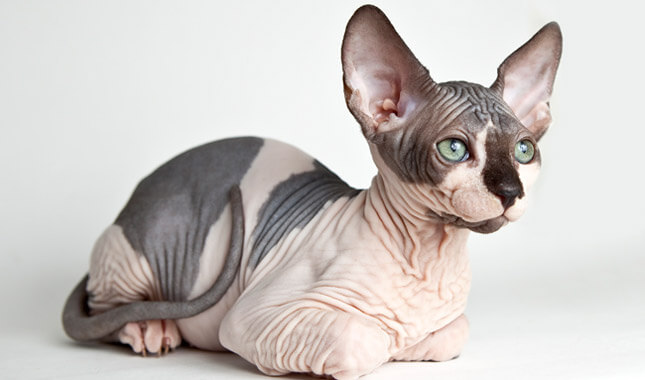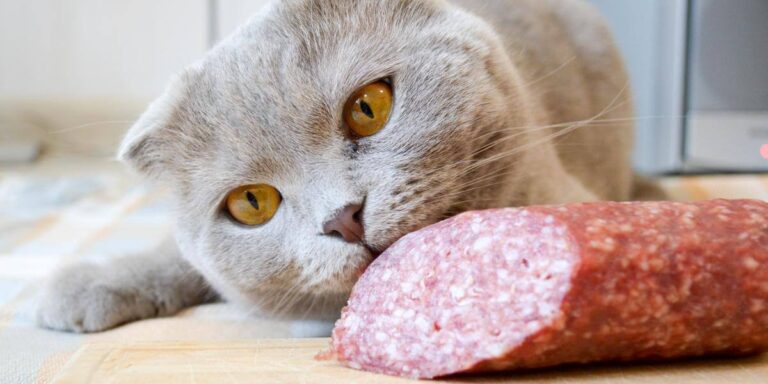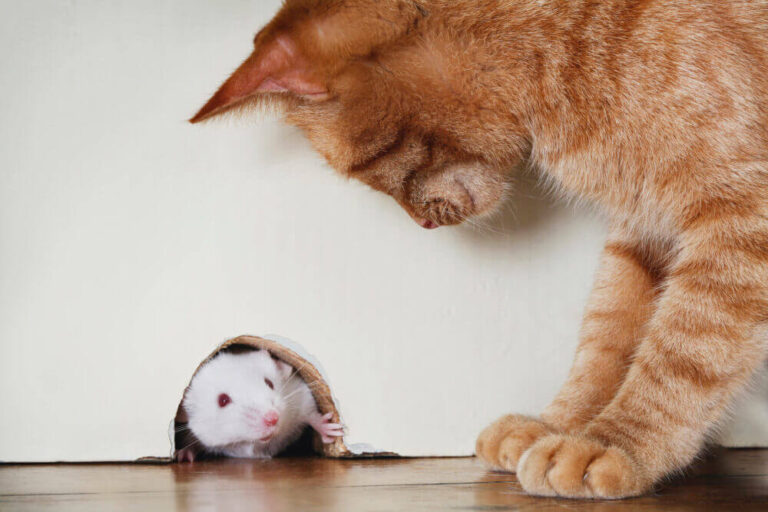Sphynx Cat Breed Guide: A Hairless, Playful Companion
The Sphynx cat, known for its unique hairless appearance and peach-fuzz coat, has captured the hearts of pet enthusiasts worldwide. With a personality that combines loyalty, playfulness, and affection, this breed is often compared to dogs for its devotion to its human companions. This guide will dive into everything you need to know about the Sphynx, from its distinctive look to its special care needs and health considerations.
Contents
- 1 Overview and Personality Traits
- 2 Physical Characteristics and Appearance
- 3 Breed History and Origin
- 4 Care Requirements and Grooming Tips
- 5 Exercise and Activity Levels
- 6 Diet and Nutritional Guidelines
- 7 Health and Common Conditions
- 8 Pros and Cons of the Breed
- 9 Where to Find or Adopt a Sphynx Cat
Overview and Personality Traits
The Sphynx cat stands out for its lack of fur and wrinkly skin, giving it a soft, warm texture similar to suede. Friendly, energetic, and always ready to play, Sphynx cats are perfect for people who love interactive and affectionate pets. They tend to form strong bonds with their owners, often following them around the house and curling up on laps. This breed is:
- Weight: Less than 12 pounds
- Length: 13 to 15 inches from head to tail
- Coat Type: Nearly hairless, with a fine layer of peach fuzz
- Color Variations: Any color, including black, white, red, lilac, and various patterns (e.g., bi-color, tabby, tortoiseshell)
- Temperament: Affectionate, social, and energetic, making them suitable for families, singles, and multi-pet households.
- Kid and Pet Friendly: High tolerance for children and other animals, including dogs.
While these cats thrive with plenty of companionship and attention, they may feel anxious or lonely when left alone for long periods, making them better suited for owners who can provide daily interaction and care.
Physical Characteristics and Appearance
Sphynx cats are instantly recognizable due to their lack of traditional fur and their muscular, medium-sized bodies. Some key features include:
- Skin Texture: Often described as peach-fuzz or suede-like; this coating can vary from nearly bald to having a fine fuzz.
- Ear Size: Large, creating an almost elf-like look that adds to their expressive face.
- Eye Color: Any possible feline eye color, including blue, green, amber, and more.
- Build: Sleek, muscular body with a long, slender tail.
This hairlessness requires extra grooming care, as there’s no fur to absorb natural body oils, which can lead to skin issues or oil buildup if not managed. Additionally, they can experience more skin irritation than furred cats, which affects how owners manage their grooming routines.
Breed History and Origin
The Sphynx cat breed is relatively new, originating from a genetic mutation that led to a hairless kitten in Toronto, Canada, in 1966. Named after the famed Egyptian Sphinx statue due to its regal, mysterious look, the breed became known as the “Canadian Hairless.” American and Canadian breeders further developed the breed by crossbreeding with Devon Rex cats, solidifying its unique traits and establishing it as a distinct breed. The Sphynx was recognized by major cat associations, including The International Cat Association in 2005 and the Cat Fanciers’ Association in 2002.
Despite its popularity, some pet organizations debate the ethicality of breeding for hairlessness due to potential health risks. However, responsible breeding practices have helped address many of these concerns.
Care Requirements and Grooming Tips
Unlike furred cats, the Sphynx requires regular skin care to remove excess oil and prevent skin problems. Key grooming needs include:
- Bathing: Weekly or biweekly baths are essential to prevent oil buildup. Use gentle, cat-specific shampoo.
- Ear Cleaning: Regularly clean the ears with a cotton ball (not a swab) to avoid wax buildup and potential infections.
- Nail Trimming and Dental Care: Routine nail trims and dental hygiene are essential for overall health.
While they are not entirely hypoallergenic, Sphynx cats are often recommended for allergy sufferers as they shed less dander than furred cats.
Exercise and Activity Levels
The Sphynx is a lively and curious breed, loving to explore, jump, and play. They are natural athletes, known for their:
- Playfulness: They often engage in activities like fetch, and interactive toys are ideal for them.
- Social Nature: Sphynx cats enjoy being around people and other pets, often following their owners from room to room.
Regular play and interactive toys help keep them entertained, especially since they don’t like being alone for long periods.
Diet and Nutritional Guidelines
Sphynx cats have a high metabolism and may need smaller, frequent meals throughout the day to support their energy levels. A balanced diet should focus on:
- Protein: High in protein to support their active lifestyle.
- Fats and Carbohydrates: Moderate fat intake and minimal carbs help maintain a healthy weight.
- Special Considerations: Some Sphynx owners prefer a raw diet, but always consult a vet for proper nutrition guidance.
Sphynx cats are known for their hearty appetites, so portion control is essential to prevent obesity.
Health and Common Conditions
While generally healthy, the Sphynx breed has a few health concerns to consider:
- Hypertrophic Cardiomyopathy (HCM): A common heart condition that causes thickening of the heart muscle.
- Skin Issues: Hairlessness makes them susceptible to sunburn, rashes, and skin irritations, so monitor their skin condition and sun exposure.
- Dental and Gum Health: Regular dental check-ups are essential to prevent periodontal disease.
Routine vet visits and preventative care are important to catch potential health issues early.
Pros and Cons of the Breed
Pros
- Highly affectionate, social, and dog-like in personality.
- Minimal shedding, which is ideal for those sensitive to pet fur.
- Loyal and playful, making them an excellent family pet or companion for singles.
Cons
- High-maintenance grooming due to lack of fur.
- Susceptible to temperature changes, requiring a warm, indoor environment.
- Prone to specific health concerns like skin issues and heart conditions.
Where to Find or Adopt a Sphynx Cat
Finding a Sphynx cat can take time, as they are popular but less common in shelters. For those set on adopting, online pet adoption platforms such as Petfinder and Adopt-a-Pet may have mixed-breed Sphynxes available. For a purebred Sphynx, contact reputable breeders, preferably ones recommended by cat associations or those found at cat shows. When selecting a breeder, always ensure they follow ethical breeding practices and provide health guarantees.
Additional Resources and FAQs
If you’re interested in other unique cat breeds, consider exploring the Devon Rex, Bengal, or Siamese breeds, known for their distinct looks and personalities.
Frequently Asked Questions
Are Sphynx cats expensive?
Yes, Sphynx cats are generally quite expensive due to their rarity, specialized care needs, and popularity. On average, a Sphynx kitten from a reputable breeder can cost between $1,500 to $3,000, though prices can reach up to $5,000 for cats with exceptional pedigrees. Their unique grooming and care requirements, such as regular skin treatments and specific diets, can also add to the ongoing cost of ownership.
Are Sphynx cats from Egypt?
No, Sphynx cats are not originally from Egypt. Despite their name and resemblance to ancient Egyptian art, Sphynx cats were actually developed in Canada. The breed began with a hairless kitten born in Toronto in 1966 due to a natural genetic mutation. Since then, breeders in North America and Europe have selectively bred Sphynx cats to create the hairless, affectionate breed we know today.
Why do Sphynx cats have no hair?
Sphynx cats have no hair due to a genetic mutation affecting the KRT71 gene. This gene regulates hair follicle development, and the mutation results in a lack of the typical fur coat found in other cats. While Sphynx cats are hairless, they may have a fine layer of fuzz, giving their skin a soft, peach-like texture. This hairlessness also means they need special grooming and protection from temperature extremes.
Do Sphynx cats smell?
Sphynx cats can sometimes develop a noticeable odor due to oil buildup on their skin. Unlike cats with fur, which absorbs oils, a Sphynx cat’s skin naturally becomes oily over time and needs regular cleaning. Weekly baths with mild, cat-safe shampoo are generally recommended to keep their skin healthy and odor-free. Their folds and wrinkles can also trap dirt, so owners should regularly clean these areas to prevent any unpleasant smells.
What is the cheapest cat?
If cost is a primary consideration, domestic short-haired cats (often found in shelters and rescues) are typically the most affordable. Adoption fees for these cats usually range from $50 to $200, covering initial vaccinations, spaying or neutering, and sometimes even a microchip. Mixed-breed cats tend to be less expensive than purebreds, and they often have fewer health issues associated with specific breed traits.
How long do hairless cats live?
Hairless cats, including Sphynx cats, generally live between 8 to 15 years, though some can live longer with proper care. Routine vet visits, a balanced diet, and special attention to skin health can help them reach their full lifespan potential. It’s essential to monitor their health carefully, as hairless cats can be prone to certain genetic conditions, such as hypertrophic cardiomyopathy (HCM), a common heart disease.
Are Sphynx cats good or bad?
Sphynx cats are generally regarded as wonderful pets, known for their affectionate and friendly nature. They’re highly social, playful, and often described as having dog-like loyalty. However, they do require high-maintenance grooming and are not ideal for people who prefer low-care pets. If you’re seeking a loving, interactive pet and are prepared for the extra care involved, a Sphynx can be a rewarding companion. For some, the breed’s care needs could be seen as a downside, so it’s essential to consider if their requirements match your lifestyle.
Do Sphynx cats meow?
Yes, Sphynx cats are known to be quite vocal and will often communicate with their owners through meows, purrs, and other sounds. They are expressive cats that use vocalizations to show affection, ask for attention, or even express displeasure. Their social nature means they may meow more frequently than other breeds, and many owners find this adds to their charm and personality.
Can hairless cats go outside?
While hairless cats like the Sphynx can go outside, it’s important to take precautions. Due to their lack of fur, they are vulnerable to sunburn, extreme temperatures, and injuries. If you choose to let a Sphynx cat outdoors, always monitor them, apply pet-safe sunscreen, and avoid prolonged exposure to direct sunlight. Many Sphynx owners prefer keeping them as indoor cats to protect their sensitive skin and ensure their safety.
Are Sphynx cats hypoallergenic?
No, they still produce allergens, although they may shed less dander than furred cats.
Do Sphynx cats need sunscreen?
Yes, for any sun exposure, a pet-safe sunscreen is recommended, especially if they spend time near windows.
What should I feed my Sphynx?
A high-protein diet is ideal. Consult your vet for specifics.
The Sphynx cat is an exceptional choice for cat lovers who appreciate a pet with a big personality and unique appearance. With proper care, grooming, and attention, these cats can be wonderful, affectionate companions, bringing warmth and joy to any household.
- Are Rottweilers Good With Kids? Reasons & Training Tips - 17 September 2025
- How Long Are Dogs Pregnant: Complete Guide - 16 September 2025
- German Shepherd Doberman Mix: Info, Pictures, Care & More - 11 September 2025







